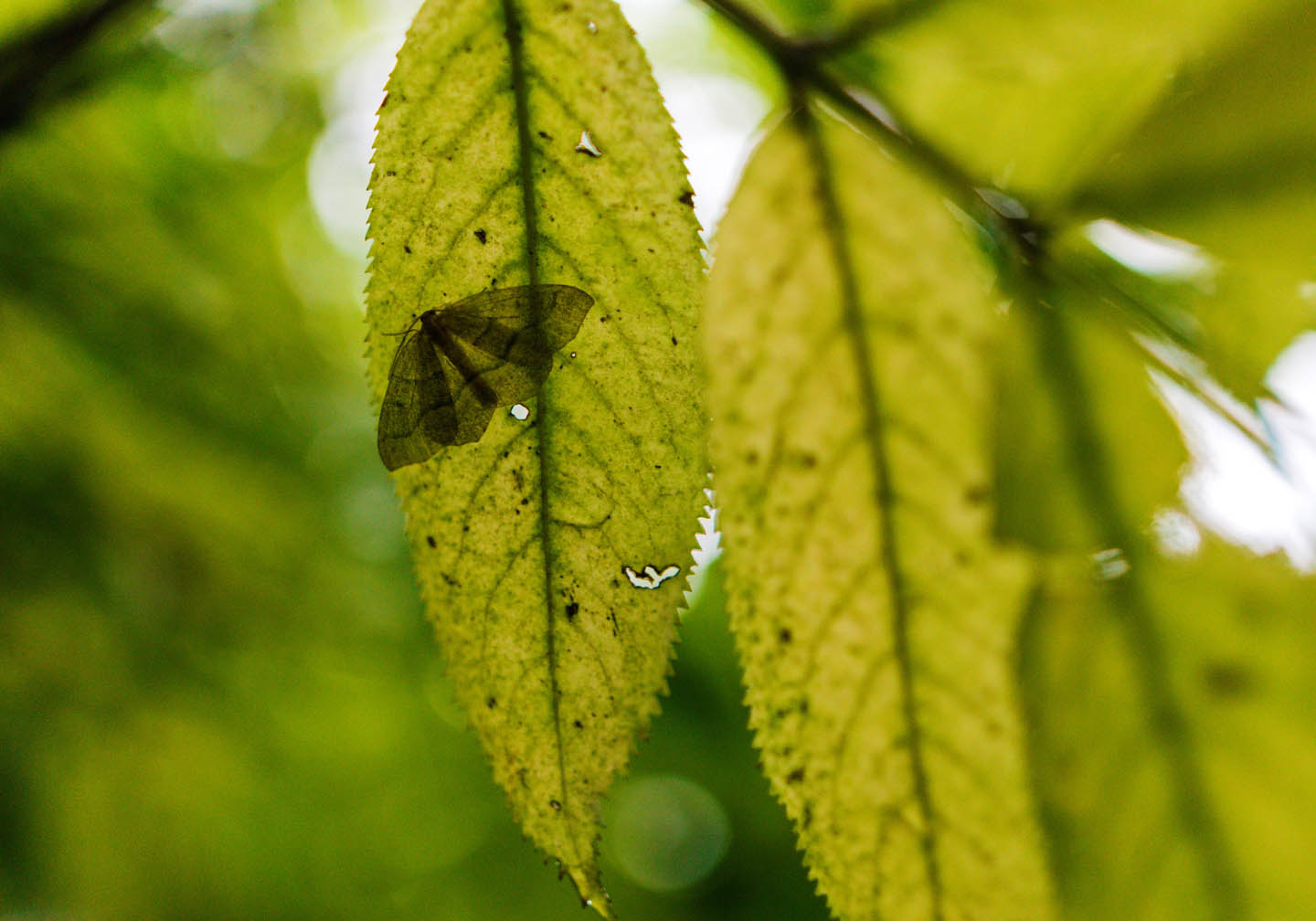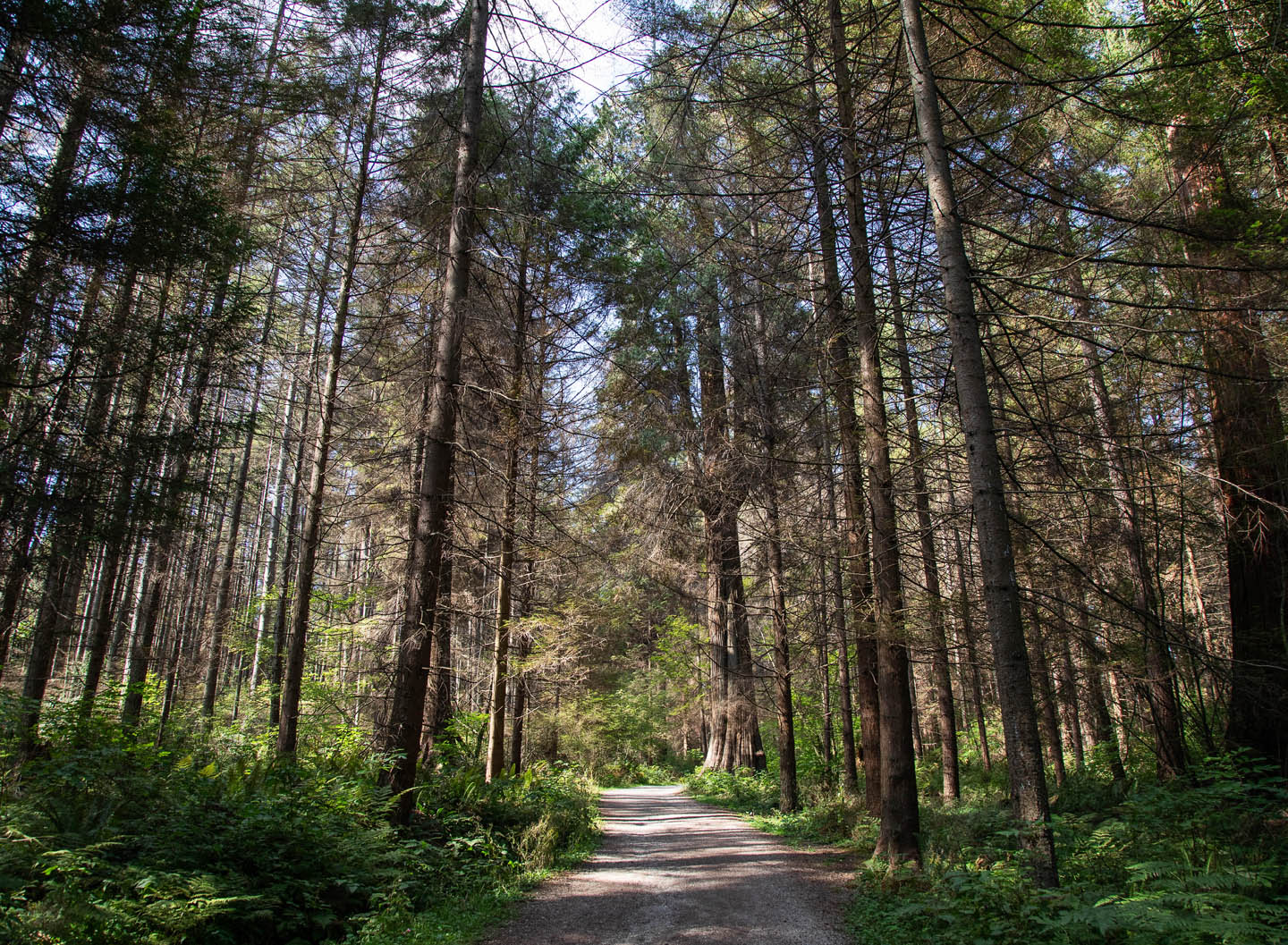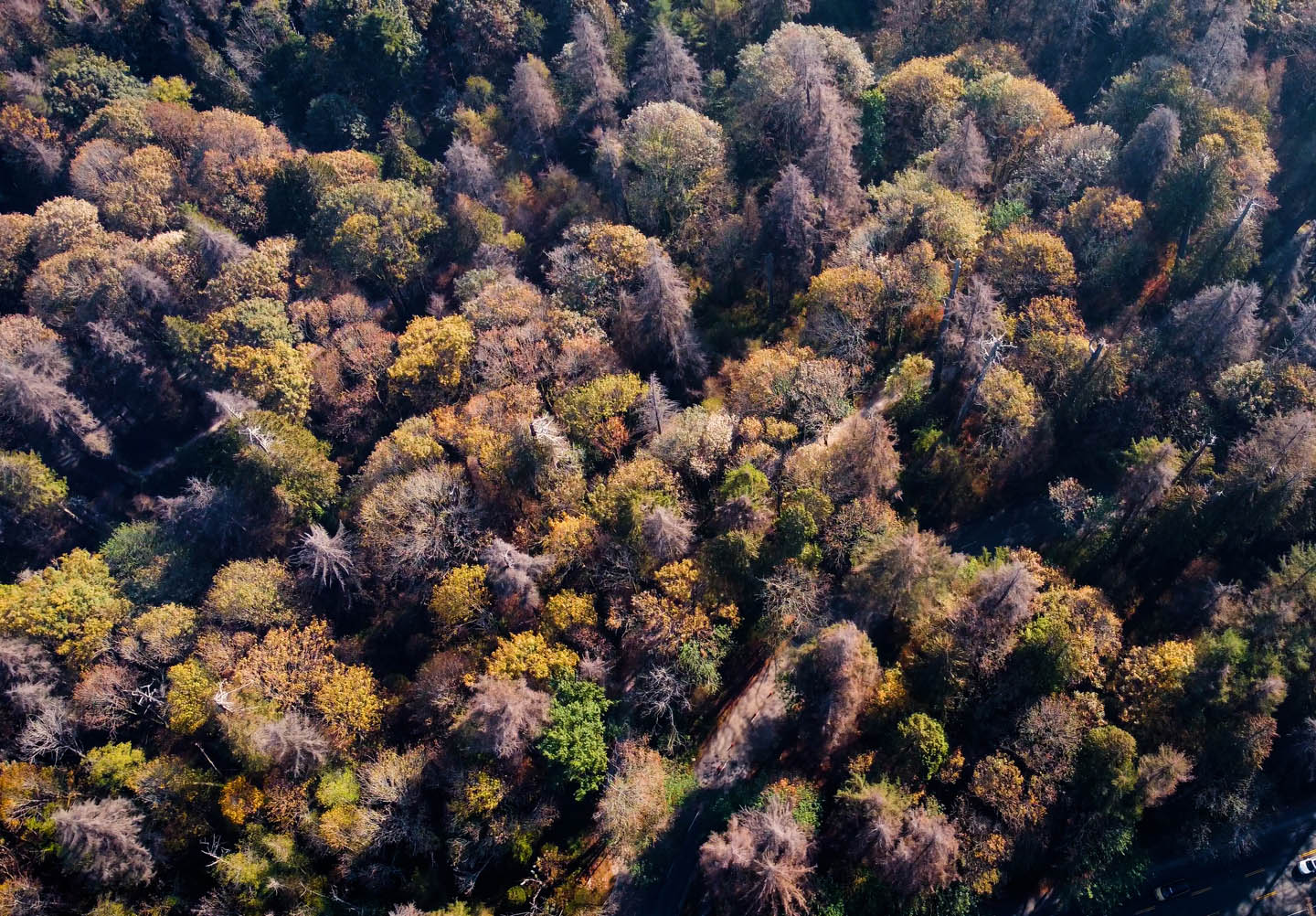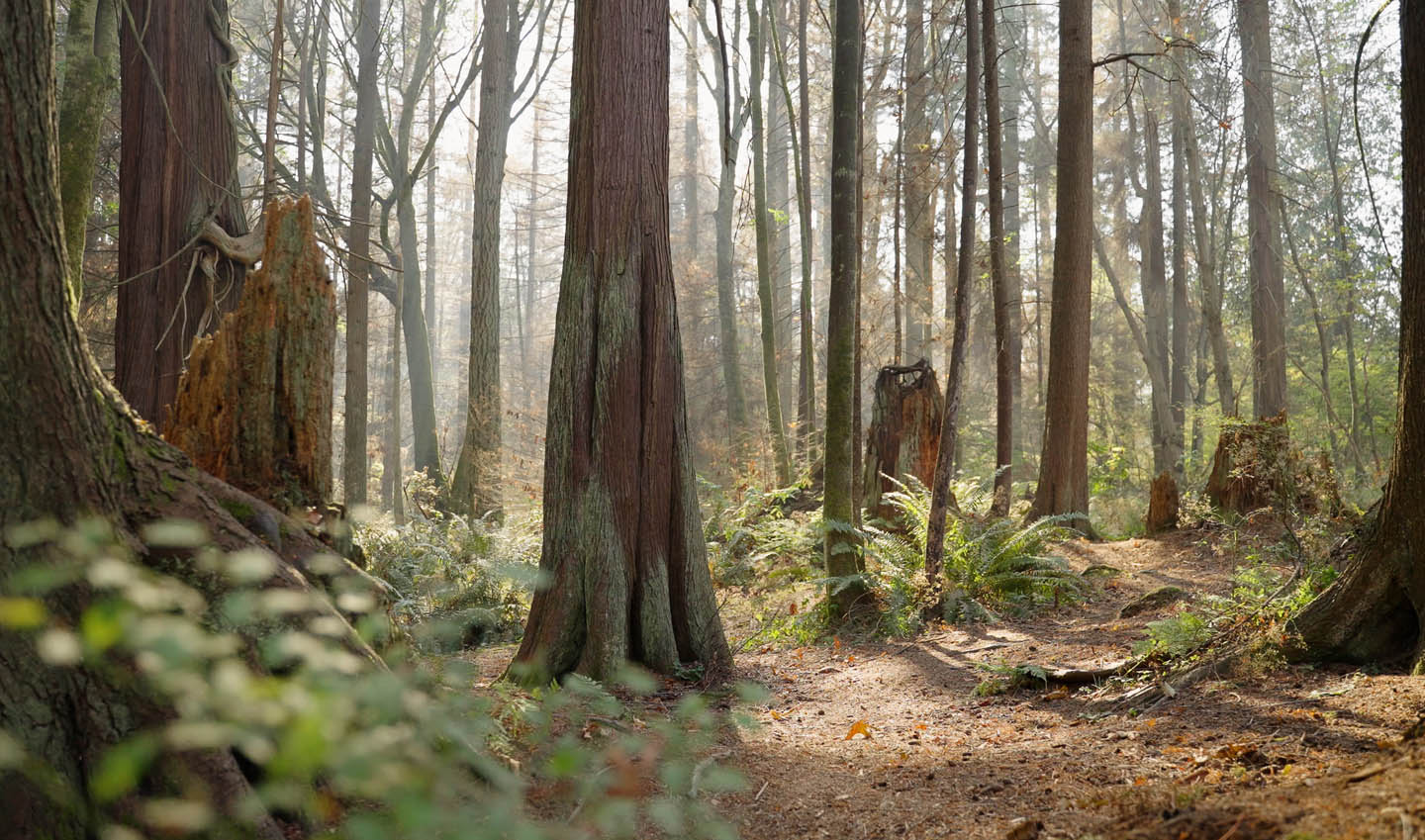Wander along any of Stanley Park’s more than 27 kilometres of trails, and you’ll encounter some of the 1,500 native species of plants, fungi, invertebrates, birds, and mammals that live in this 400-hectare urban forest. You might see northern saw-whet owls, beavers, coyotes, or the roller-coaster trajectory of bats. Deep in the forest, you can kneel and examine vibrant-green strands of silky forklet-moss or crane your neck to take in the crowns of massive western red cedars. And you may have to dodge the glossy strands of Lambdina fiscellaria larvae as these mottled greyish-brown inchworms descend from the overstorey.
It’s these innocuous-looking little caterpillars that morphed into western hemlock looper moths during the “mothpocalypse,” an outbreak that has plagued Vancouver for a few years and helped kill 25 per cent of the trees in the park. Some 160,000 affected trees have died and are being cut down by the city.
The moth is also known as the mournful thorn, and the name fits, given its rather dour and hoary appearance and the damage this wee creature has caused in Vancouver’s most-beloved park. The fluttering miscreants are native—their natural cycle of infestation lasts about three years every two decades—yet have been an ongoing issue in the park since its inception in 1888. A 1914 report stated that 25 per cent of western hemlock trees had died and 60 per cent were affected by the insects.
Warmer and drier conditions in an area that’s typically wetter—like Stanley Park—make trees more prone to disease and damage by insects, while the cold-blooded insects thrive in the heat.
Now, more than 100 years later, the mournful moth’s impact is exacerbated by severe drought and “unhappy trees,” as Dr. Allan Carroll describes the state of the forested park. A professor and director of the forest sciences undergraduate program at the University of British Columbia, he studies the effects of climate change and eruptive insects on forests—and takes his students into Stanley Park to study such biotic disturbances. He says warmer and drier conditions in an area that’s typically wetter—like Stanley Park—make trees more prone to disease and damage as the cold-blooded insects thrive in the heat.
Candace Campo adds another dimension: “The forest is no longer being fed.” A member of the Shíshálh Nation and founder of Talaysay Tours, Campo has long led the popular Talking Trees walking tour in Stanley Park and is keenly aware of the ebb and flow of its flora and fauna. “We are not formal scientists, but our peoples’ approach of observing the land and the forest, year after year, day after day is its own form of science,” and the reality is “very large portions of the forest are dying.”

The multiyear “mothpocalypse” has helped kill 25 per cent of the trees in Stanley Park. Larvae of the western hemlock looper moth devour the leaves.
And it’s not just the western hemlock that’s affected. Campo tells me the older ancient trees, such as those towering red cedars, are not as drought resistant. Medicinal plants and berry bushes aren’t yielding as much. Plants get confused with shifts in the weather patterns and bloom too early. The looper moth, of course, has been conspicuous and “getting a lot of blame,” but Campo sees a larger systemic issue.
“We only have 10 per cent of the salmon that we once had in 1850,” Campo says. Just 150 years ago, an estuary network of streams stretched more than three kilometres inland, and salmon runs sparked a cycle of life, feeding animals—from bears to ospreys—who then fed the forest with fish carcasses, returning nutrients to the soil. Stanley Park is so important, she says, because it’s the last vestige of this ancient forest that was harvested—decimated within a 30-year period when white settlers bought land cheap and logged it.
“There’s been some real sadness,” Campo says of the current state of the park. “There’s been some tears, to be honest, amongst some of our team, our cultural ambassadors. There’s such a strong cultural connection to the land. And many of our families come from there. That’s their winter village.”
Witnessing the aftermath of the culling, Campo says, was “quite impactful,” but some of those logs will go to the host First Nations for ceremonial firewood and carving, while some of the larger dead trees with a diameter of 20 centimetres or more will be left in place as nurse logs to regenerate the ecosystem (as Carroll puts it, “lots and lots of things depend upon dead trees”). The rest of the 140,000 cut trees are younger, smaller, and a fire hazard. Most of these have been chipped into mulch or ground as green waste.

The largest now-dead western hemlock in the park will likely remain standing, says Ira Sutherland, a forester and social-ecological systems researcher. It’s off the trails in an ecologically important area where it poses little risk. It’ll live on through its seedlings and as a habitat for species such as the bald eagles that perch on tall dead treetops and pileated woodpeckers that pick apart old hemlocks for food.
As a member and former chair of the BC BigTree Committee, who’s also given tours of the oldest and biggest monument trees in Stanley Park, Sutherland guesses that particular hemlock reached about 350 years before being completely defoliated by the looper larvae. But he also says hemlocks don’t tend to live much longer—unlike the park’s 600-year-old Douglas fir that’s been around since Joan of Arc.
Like Campo, Sutherland talks with reverence about the Great Vancouver Forest that existed before the city consumed it and says Stanley Park is the easiest place to interact with what’s left of it. “It’s pretty special that we’ve got not only a nice swath of old-growth forest at the foot of downtown but also some remarkable trees: the largest maple tree in Canada, the largest red alder in B.C., big Douglas firs, really impressive red cedars. It’s an exceptional piece of forest.”
Yet it’s also an isolated fraction of the contiguous forest that used to be here. Without the exchange of organisms and seed sources and pollen—that cycle of life—its sustainability is dependent on human intervention. It’s also in the middle of a metropolis. “That’s the challenge to an urban park like Stanley Park,” Carroll says. “You can’t let the natural processes necessarily run their full course, because to do so would have a direct contravention of either public safety or sometimes even public interest.”
Forest management has always been contentious in the park, based on colonial views of what nature should be.
Sutherland sees Stanley Park as a place where “different values and interests and worldviews collide.” He says forest management has always been contentious in the park, based on colonial views of what nature should be. “It seems like when they created the park, they were trying to set aside a wild, representative ecosystem, but then there are other ideals that have come in and tried to manicure it and clean it up and make it into a civil, orderly forest. It’s kind of like we don’t really know what Stanley Park should be at this point. Should it be this wild, natural ecosystem? Or a nice, tidy park that’s like a museum with little bits of old growth that we can enjoy?”
Ultimately, it’s now a park and no longer a self-maintaining forest. “It’s a place where people want to go and have an experience,” Carroll says. It gets intense public exposure and traffic. And anything that happens here gets amplified, whether that’s coyote bites or cut trees. As Sutherland says, “Key operational things are a bit in conflict with the purely ecological ideal vision of what it might look like. We have to strike a balance.”

The park looms as large as its old-growth trees in Vancouver’s psyche, both physically as the city’s forested backyard and as a microcosm of cultural perceptions and environmental issues. Campo says, “Many people—for generations—have a connection to Stanley Park,” as well as people new to the city who have their first forest experience there. “Have your emotional reaction,” she says, grieve and commemorate, but also be proactive.
“There are still a lot of living trees,” Campo notes. “It may be dire, but I think we have to come together as a community—with Indigenous communities, with science in concert with conservation—and do our very best to not turn a blind eye to the problem and not look to one group as the expert.” Maybe that mournful moth is less woeful and more a harbinger of possibility.
Photos courtesy of Vancouver Park Board. Read more from our Spring 2024 issue.









